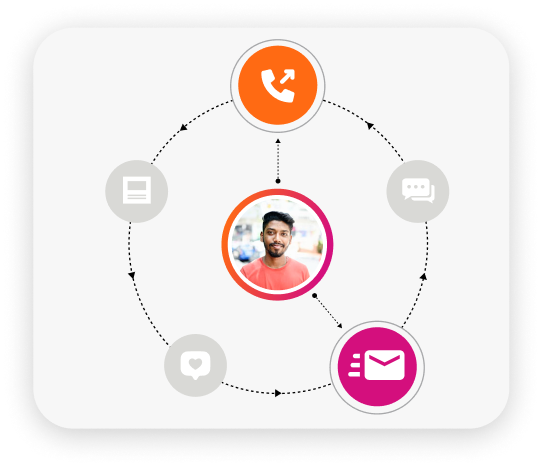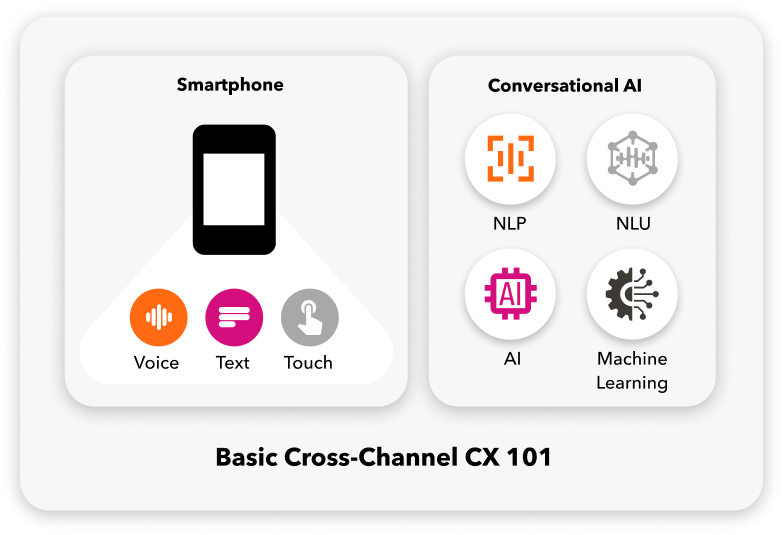Introduction to Multimodal CX
Move over, single-channel CX. Multimodal CX is taking over (and that’s a good thing). Just like smartphones replaced voice-only mobile phones—and redefined how we interact with our mobile devices—multimodality is transforming our customer experience interactions. And the evolution is gaining speed. Soon, most, if not all, customer experiences will be multimodal experiences. There is no going back.
Even if you’ve never heard of multimodal CX by name, odds are you’ve interacted with it. That’s because more and more companies are adopting the technology—and for good reason. Multimodal CX solves several self-service pain points experienced by customers across all industries and, as a result, increases self-service adoption rates. And in a world where more customers prefer self-service—and have higher CX expectations than ever—delivering a positive experience matters. (Of course, saving money by deflecting low-value calls away from the contact center doesn’t hurt either.) With that in mind, let’s take a closer look at just what multimodal CX is and what it takes to create a winning multimodal experience.
What is Multimodal CX?
Attend a customer experience industry event these days and you’ll most likely hear the terms “multi-modal” or “multimodal” or “multimodality” used to describe a method of communicating with customers. As its name implies, multimodal CX enables customers to communicate with a brand using multiple modes of interaction: voice, visual, text, etc. So, instead of simply speaking with a chatbot, customers are also offered visual and/or textual guidance for greater clarity and navigational ease of use.

Why Multimodal CX Matters in Today’s Digital Landscape
Just how much of an impact can multimodal CX have on a company’s self-service experience? Consider this: if you’ve ever tried to pay a bill, change a service plan or update an account address on your smartphone, you’ve probably answered questions from a not-quite-human voice. Depending on how well that voicebot understood your responses, you were either guided toward successful self-resolution or reduced to shouting “representative!” at the top of your lungs.
Now, flip the script. How do you think your customers feel when they are misunderstood by your company’s automated voice recognition system? In a recent Forrester study commissioned by Uniphore, only 1 in 4 business decision-makers said that they would be extremely satisfied with the CX received as a customer of their company. That’s not good. By switching from single-mode to multimodal CX, you can create a better, more intuitive experience for customers with less chance of miscommunication.
The Rise of Cross-Channel Customer Interactions
Interest in cross-channel CX has been growing steadily for years, accelerating rapidly in the wake of the 2020 global pandemic. As a result of that experience, more people are familiar and comfortable with remote interactions than ever before. They’ve also developed a healthy appetite—and high expectations—for digital experiences. With its ease of use and fewer friction points, cross-channel CX sets the bar particularly high. And if the past is any indication, once customers develop a CX preference, there’s no going back.
The Role of Technology in Shaping Cross-Channel CX
Cross-channel CX didn’t appear out of nowhere. Several technologies are responsible for making multimodal customer experience a reality. First, there’s the smartphone, without which none of this would be possible. By enabling customers to interact via voice, text and touch, the smartphone provided the foundational hardware for all multimodal experiences.
But a smartphone alone does not a cross-channel CX make. You need the requisite software to not only connect the channels, but also to make the inputted data understandable and transferable. That’s where conversational AI comes in. Conversational AI uses Natural Language Processing and Understanding (NLP and NLU, respectively), artificial intelligence and machine learning to recognize a user’s speech or text patterns, understand their intent and accurately capture their input in a manner that can be easily shared across channels.
That’s basic Cross-Channel CX 101. More advanced platforms, like Uniphore’s multimodal AI X-Platform, leverage additional AI technologies, such as emotion AI, to uncover deeper contextual information. This data enriches the multimodal customer experience by factoring in user sentiment, tone and emotion.

Benefits of a Multimodal Customer Experience Strategy
Multimodal CX has many benefits. In fact, we’ve already alluded to a few: improving journey navigation, minimizing friction points, meeting rising customer expectations. Now, let’s get into the specifics of what a multimodal customer experience has to offer.
Enhanced Customer Engagement and Satisfaction
Multimodality closes the customer preference vs. the customer usage gap. With a multimodal experience, a customer can enter the interaction through the phone (or their preferred channel) and then expand the interaction to other channels rather than being constrained within their initial channel mode. This flexibility greatly enhances customer engagement and overall satisfaction.
Streamlined Customer Support and Services
Developing cross-channel CX isn’t just about meeting customer expectations. There are notable operational benefits to customer service as well. By connecting multiple CX channels, customer service teams have a central repository for all customer-entered data—no more asking customers to repeat information or having to manually fill multiple forms. What’s more, once the information is captured, it can be surfaced during future interactions.
Boosted Business Growth and Customer Retention
By streamlining customer experience and backend operations, multimodal CX saves considerable time and effort—both of which drive higher customer loyalty and lifetime value. Harvard Business Review said it best: “First, delighting customers doesn’t build loyalty; reducing their effort—the work they must do to get their problem solved—does.”
Implementing a Multimodal CX Strategy
Despite the benefits, multimodal experiences aren’t as commonplace as you’d think. It is still much more common to be shifted from channel to channel. Perhaps that is why a McKinsey survey said that 20% more customers would prefer to use digital channels than do today. For organizations considering implementing a multimodal experience, having the right strategy in place can make the transformation from single-channel to cross-channel CX a lot easier.
Understanding Your Customer’s Preferred Channels
Studies show that around 60% of customers will first attempt self-service. However, only about half are able to resolve their issue wholly within self-service. It is time to move away from “did you know more information is available online” in your self-service hold music and lead customers to an experience that promotes their preferences. Evaluate the customer’s journey, walk in their shoes and combine modes to fit the interaction to increase their adoption of self-service.
Integrating Technologies for a Seamless Experience
Speech is a popular channel for self-service, but to avoid cognitive overload, use speech, and visual experiences together to follow through with a multimodal experience. A caveat: disparate systems from a variety of vendors (IVR, phone, mobile apps, chatbots) often make it virtually impossible to move beyond a single-channel experience. Just because you have many channels connected together doesn’t mean that it’s multimodal. You need a platform that integrates all channels and their respective technologies to support a each interaction.
Training and Preparing Your Team for Multimodal Interactions
Multimodal CX doesn’t stop with self-service. There will always be a percentage of calls that require live customer support. The benefit of a multimodal platform is that data captured in self-service can transfer to live support seamlessly. While customer service teams will need to learn how to use the technology, the learning curve is considerably shorter than traditional live support training. That’s because technology does the heavy lifting of problem discovery, diagnosis and data entry.

Challenges of Multimodal CX and Overcoming Them
Switching from single-channel to multimodal or cross-channel CX isn’t without its challenges. From integrating multiple disparate systems to fostering consistency throughout the entire journey—organizations need to address potential technological and implementation hurdles before going “all in” on multimodality. Fortunately, overcoming these challenges isn’t as hard as it seems.
Managing Data Across Multiple Channels
Multimodal CX cannot exist without sharable data. Each mode must be able to communicate with the others for the system to work. That’s not always easy when juggling multiple systems from different vendors. Data may be siloed or gated by third parties. A multimodal AI platform that uses open APIs can unlock data from a variety of sources and structure it so it’s easily transferrable.
Ensuring Consistency and Quality of Experience
Many organizations start with a strong speech channel and build up additional modalities around it. While there’s nothing wrong with this approach, it’s important that corresponding visual and/or text modes contribute to the overall experience and don’t just clutter up the user experience. The best multimodal journeys offer a consistent, high-quality experience from end to end. That includes when users move from self-service to live support channels.
Addressing Technological Hurdles and Limitations
Each organization has its own unique technological infrastructure with its own internal challenges and limitations. Are CX systems run on site or via the cloud? Can CX teams create workflows on their own or is IT or a third-party developer involved? Low-code automation that layers on top of existing systems and channels can help businesses overcome tech-related obstacles to creating a successful multimodal customer experience.
Conclusion: The Future of Multimodal Customer Experiences
Make no mistake—the multimodal revolution is here. Soon, cross-channel CX will be the norm for (nearly) every organization, and single-channel experiences will seem as quaint as sending a fax or using a dial-up modem. That’s the nature of technology. It progresses forever toward efficiency. And that progression is inevitable.
Organizations that embrace that progress historically fare better than those that arrive late to the game. Multimodal CX is no different. Companies that offer multimodal experiences typically enjoy higher adoption and resolution rates and better customer satisfaction than their single-channel peers. That’s a considerable advantage—for now.
Embracing AI and Advanced Analytics
As multimodal CX becomes more and more mainstream, businesses will need to find new ways to differentiate themselves from the pack. That’s where advanced AI and analytics come into play. By leveraging multiple AI technologies—including generative AI, emotion AI and knowledge AI—in one multimodal AI and data platform, organizations will be able to go from delivering a seamless customer experience to creating one that is truly human-like. And with advanced, real-time analytics to train those AI models, that experience will only get better and better.
The Growing Importance of Personalization in Multimodal CX
What makes a multimodal customer experience feel more human? By personalizing it to each customer. The best multimodal experiences aren’t just intuitive; they communicate with customers on their terms. They factor in customer preferences and behaviors. They recognize their sentiment, intent and emotion in real-time and respond in kind. When CX understands customers—their feelings, perceptions and frustrations—it transcends simple problem-resolution and becomes much, much more. It becomes a driver of lifetime value and loyalty. And the good news is: it’s already here.




